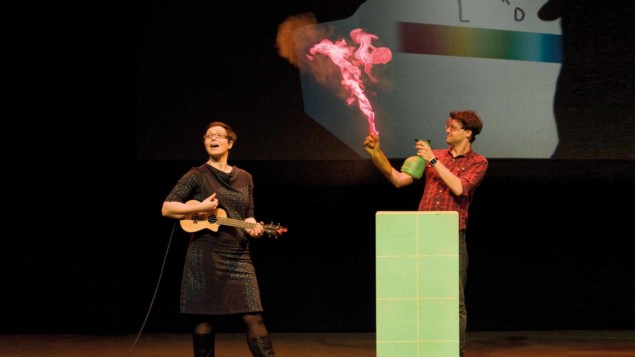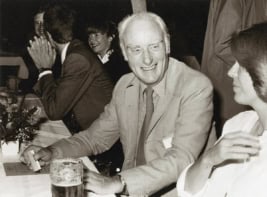Jess Wade reviews The Element in the Room: Science-y Stuff Staring You in the Face by Helen Arney and Steve Mould

Before starting the review, I should come clean – I like facts. It began when I was a child, sitting in the back of a car during long journeys to North Wales, and matured in a shared PhD office in the skies above South Kensington. At one stage my friend and I invented a game called “fact or schmact”, where, during particularly long afternoons of data analysis, we’d come up with fake facts and try to convince each other they were real.
The Element in the Room: Science-y Stuff Staring You in the Face, by Helen Arney and Steve Mould, is a turbo-charged trivia tome, aimed at scientifically minded readers with a sense of humour. It is not just a regular book, either – from recipes for cocktails to instructions on fire vortexes, it encourages you not to take what you are reading for granted, but to have a try yourself. Arney and Mould are two of the three stars of Festival of the Spoken Nerd (FOTSN) – a science-comedy performing trio. Both are physicists who are more familiar with comedy clubs than lecture theatres – they are now professional science communicators. Matt Parker, the “third nerd”, contributes in the preface and blurb – but only to promote his own book. FOTSN has taken live science shows to tens of thousands of people across the UK, gained hundreds of thousands of followers on YouTube and contributed to television and print media. I’ve never actually seen a show, but the writing is so enchanting that after a few chapters, I was searching for when they are next in town.

Of graphs and giggles
For those who may shun popular-science and think of themselves as “above” social media – this isn’t all fun, games and festivals. In 2013 Mould asked on YouTube why chains of beads leap out of jars in arcs before falling to the floor, and the video went viral (at the time of writing it has been viewed almost two million times). The video was picked up by two professors at Cambridge, who went on to help Mould explain the “self-siphoning beads effect”, and published their discovery in the Proceedings of the Royal Society A (it also made its way into Nature, Science and the Daily Mail). The journey from observation to result is detailed in a section that makes the case for the mantra of the majority of science communication and suggests that anyone curious can and should contribute to our understanding of the world. You don’t need a fancy research lab or PhD, you just need to question the world around you.
While I may be reading too much into it, The Element in the Room feels like science communication by stealth. The facts may be loosely collected into chapters such as “Food stuff” and “Body stuff”, but physics is at the heart of most of the “stuff” they cover. Arney and Mould are excellent storytellers, whose accidental discoveries and anecdotes read like science experiments. They show that physics is at the heart of the majority of everyday phenomena. In “Brain stuff”, Arney perfectly describes impostor syndrome with an internal dialogue between three Helens. Arney debunks popular neuroscience myths (left brain/right brain, men’s and women’s hobbies) – perhaps thanks to her physics training – but is so non-judgemental you find yourself laughing with her rather than being angry at how ridiculous society’s biases are to begin with. She’s an incredibly empathetic writer (or a mind-reader) – in the only section I began to find a bit trying, a list of how chemical elements got their names, Arney interjects with “I hope you’re memorizing this, there will be a test at the end.”
Arney and Mould recognize that in an age of social media and globalization their readers won’t all be in the UK, and seem to enjoy translating observations for a trans-Atlantic audience. When describing the science behind instant coffee they take the time to explain what instant coffee is, then use American tea as a proxy for just how awful instant coffee can taste. The Element in the Room is timely, too. A do-it-yourself experiment includes creating smoke-rings from a friend who is vaping. They are aware we live in a time of “alternative facts” and they include a “Trip Advisor for exoplanets”. Despite coming out pre-Cambridge Analytica scandal, there is even a section on the pseudo-science behind personality tests.
This book has been beautifully put together – the illustrations by Richard Wilkinson are technical without being textbook-like and the layout feels like it has been created by people who not only care about what they have to say but how they communicate it. Perhaps not unsurprisingly given their extensive experience, the writing is accessible and light without being patronizing or preachy. Even without seeing the live show, the chemistry between Mould and Arney is perfect – sections are written by either one or the other and you can only tell which if you hunt for Wilkinson’s small symbols in the margin. Of course, as an almanac for nerds, the book comes with instructions. While there is no doubt that this book would make an excellent gift for enthusiastic teenagers or early-career researchers, The Element in the Room isn’t only millennial material, so don’t let them have all the fun.
-
2017 Octopus Publishing Group £16.99hb 224pp



